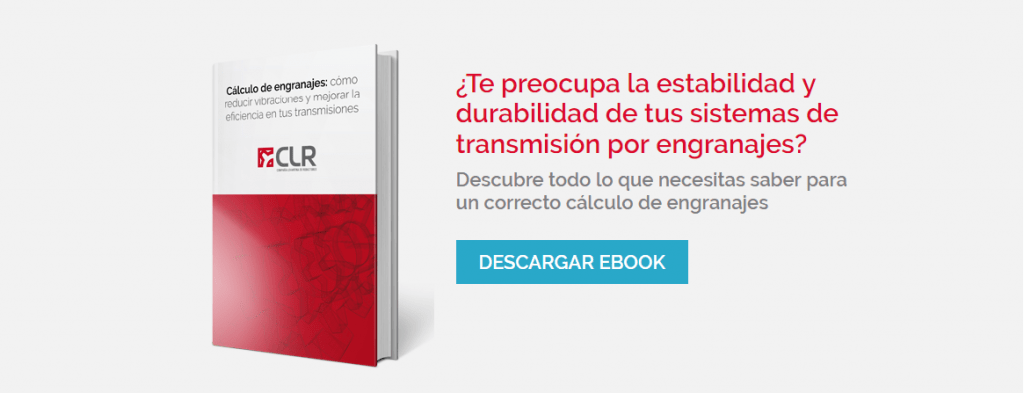Las gear transmissions are present in sectors as diverse as the automotive, aeronautical, mining and steel industries, among many others.
Next, we will learn what gear transmissions consist of, what are the parameters of your design or what materials are used for their manufacture.
Free download: Gear calculation: Improve efficiency in your transmissions
What are gear transmissions: definition
Las gear transmissions are mechanisms formed by two toothed wheels which are attached tooth to tooth and are called crown (in the case of the larger one) and pinion (in the case of the small one). One acts as Motorized or conductive, and the other of conducted.
They are widely used in precision machinery due to the accuracy, compared to other gears, they achieve in the transmission ratio.
Los high torques of force at high speeds rotational properties are obtained thanks to the rigidity and great surface hardness of various materials, especially tempered steel, under a surface cementing treatment.
Gear transmissions stand out for their accuracy in the transmission ratio, making them ideal for precision machinery
La transmission ratio in a gear transmission it can be set using the formula rt=Ω 2/Ω 1, where:
- Ω 1 Is the speed of rotation of the driving wheel
- Ω 2 is the speed at which the driven wheel rotates.
- It is called the drive shaft or 'input' To the driving wheel supportive to the input axis and 'output' to the wheel attached to the output shaft and conducted
Advantages of gear transmissions
Gear transmissions replace belts and pulleys in many applications, especially industrial ones, due to the advantages represented by:
- Evitan the possibility that they occur landslides. Even at high speeds, gear transmissions can operate without the risk of slipping or 'skidding' due to the tension generated in the mechanism. this Avoid breakdowns and accidents, in addition to making the transmission of forces more precise.
- Tienen high power transmission capacity. Not only do they transfer power with great efficiency, but they can do so from the axis of an energy source to another axis that is far away. This occurs, for example, in internal combustion engines.
- Long lifespan with low maintenance. Gear transmissions require a periodic lubrication with oils so that the heat generated by the friction between the teeth of both crowns does not cause deterioration in the mechanism. This maintenance is sufficient for optimal and prolonged performance.
- Usable in small spaces. Unlike other transmission mechanisms, the gears do not require a large space and can be used in small or difficult to access places. This is especially useful in industries such as automotive or vending.
Gear transmissions prevent slipping, have high power transmission capacity, a long lifespan with little maintenance and can be used in tight spaces
Elements of gear transmissions: the geometry of the tooth
La geometry of the tooth of a gear wheel is determined by a series of variables, among which the following stand out:
1. Circular step
In the primitive circumference, it is the distance between homologous points corresponding to two teeth that one be found after the previous one.
Por primitive circumference We mean the circumference by which I would roll the gear without slipping. It receives the name of P, and can be calculated by adding the thickness of the tooth and the width between two teeth of the wheel that are arranged consecutively.
2. Module
Of this variable, m, It depends on the good gear of the crown and the pinion.
Respond to the formula m=D/z, in which m is the result of dividing the primitive diameter by the number of teeth.
m = D/z
3. Diametrical step or DP
Expressed in inches, it is the quotient between the number of teeth and the primitive diameter.
4. Head circumference or Ra
It's the outer contour that reach the teeth.
5. Foot circumference or Rf
It is the contour that limits the space between the teeth on the underside.
6. Addendum or has
It's the radial distance between the head of the tooth and the circumference primitive. It is also referred to as 'head height'.
7. Dedicated to HF
It is the radial distance that exists between the primitive circumference and the root of the tooth. It is also called 'foot height'.
8. Total height o H
It is the total of foot and head heights.
9. Side game
When two teeth mesh together, there remains a free space which is referred to as clearance or side clearance.
Other relevant variables of the tooth geometry are the tolerance (c); the working height (hw); the gap (e); the thickness of the tooth (s); the face of the tooth; the flank of the tooth; the width of the flank (b) or the pressure angle (α)
Design parameters in the gears
The main parameters that define the transmission ratio They are:
- Gear condition
The gear condition It is fulfilled when the pressure line, which is the surface on which the teeth come into contact, It goes through a fixed point at all times within the defined line of centers. Specifically:
- It is the situation in which The imaginary line that connects the two centers of rotation of the gears passes through the O point at all times.
- This 0 point is The point of contact between the two teeth that mesh together in a normal layout.
- In addition, there must be a Length coincidence between the primitive radii of the gears and the distances from point O to the respective centers.
- Coating coefficient
The contact relationship (E) reflects the average of teeth that keep in contact at all times.
For efficient and low-noise operation, the usual thing is that ≤ > 1.2
The coating coefficient is result of dividing the action arc by the base step, the arc of action being the sum of the arc of approach (qa) with the arc of retreat (qb), and the base step.
- Transmission ratio
The transmission ratio (RT) is the result of the division between the output speed and the input speed (rt = Ω 2/Ω 1).
In other words, it is the Relationship between rotational speeds of both gears.
You may be interested in: Steps to calculate the gear transmission ratioS
Multistage gear transmissions are sometimes used. Depending on the relationship between the two axes that you want to obtain, a specific number of steps will be used.
How are gears made?
The process of manufacturing the gears is carried out in several phases. Depending on the type of device you want to obtain, a series of guidelines will be followed:
- Machining. El gear machining is the process by which You get the toothed wheels, whether in metallic, polymeric or other materials. Milling machines and lathes pre-prepare, depending on the use they are going to receive, the gears.
- Injection. The injection is used for plastic gears, which are at a time of growth due to the advantages offered by this material. It is a type of manufacture that provides a high quality and the highest precision in the geometric parameters.
Forms of gear lubrication
During operation of a gear, the impact force between the teeth that are meshed must be reduced to ensure the durability of the mechanism. On the other hand, this force produces a constant friction and usually has irregularities on the surfaces of these teeth.
So that all this does not reduce the useful life of the gears and they remain operational in optimal conditions for as long as possible Lubrication is used.
In addition to preventing tooth corrosion, lubrication is used to remove heat and reduce contact tensions
The main forms of lubrication of the gear transmissions are:
- Immersion in lubricating oil
- Pressure lubrication
- Periodic lubrication in accordance with an established maintenance plan
Both immersion lubrication and pressure lubrication are performed in closed transmissions, while periodic lubrication is reserved for open transmissions.
What are the manufacturing materials of gears?
Steels, plastics, gray cast iron, aluminum..., there are numerous materials used for the manufacture of gears.
Inside the steels, we can differentiate between:
- Forged stainless steels
- High strength steels
- Cast or forged aluminum alloys
- Other alternatives are copper-based alloys and magnesium alloys.
Los gears made of steel, subsequently subjected to tempering and cementing treatment, are used When great forces need to be transmitted and in circumstances where durability is particularly demanding.
Steel subjected to a tempered treatment is one of the most used materials in the manufacture of gears
On the other hand, the use of fireproof plastics is increasingly widespread, highlighting the polycarbonate (PC), polyamide or PVC, as well as acetal resins. Among the non-combustible ones, the most commonly used are polyethereterketone PEEK, the polytetrafluoroethylene (PTFE) and the polymers of liquid crystal (LCP).
In addition, high-performance polymers are starting to exist, such as:
- PPS - Polyphenylene Sulfide
- PEI - Polyetherimide
- PVDF - Polyvinylidene Fluoride
- PES - Polyethersulfone
- PI - Polyimide
- PPSU - Polyphenylsulfone
- PSU - Polysulfone
To learn more: Why improve your safety mechanisms with fireproof plastics
How to choose the right provider and transmissions
La choosing the most suitable transmission determines the success of its operation. But not only that, but the performance of the machinery it will be conditioned by the type of mechanism it works with.
Also the precision and durability of the transmission itself it will depend on whether the material in which it has been manufactured is ideal for the demanding conditions in which you are going to work.
Related Reading: Tips to keep in mind when buying gears
Levantine Reducer Company (CLR) has more than 40 years of manufacturing, designing and assembling the highest quality gears for the industry. Its extensive experience in the design and calculation of gears for different applications make it a reference in the sector.
CLR is based on the work of a professional and experienced team, at the forefront in the use of the latest technologies, for the design, manufacture and sale of gears, both made of metal and plastic, that allow achieving the best results in electromechanical transmissions and drives of all kinds.
Do you need advice when it comes to choose your transmissions by gears? Not sure what type of materials are most suitable for your industry? Do you want cCorrect noises or vibrations in your current systems? For this and other needs you may have in your engineering projects, don't hesitate to Contact NosoTRos. We'll help you find the perfect move.

We offer customized, tailor-made solutions. Configure with us the perfect gearmotor for your project.
¿Tienes un proyecto en mente?
We can manufacture your tailor-made solution, we accompany you at every stage of the project to offer the solution that best suits your application.
Do you have a project in mind?
We can manufacture your tailor-made solution, we accompany you at every stage of the project to offer the solution that best suits your application.









